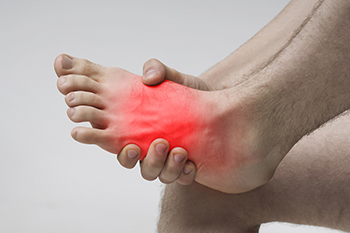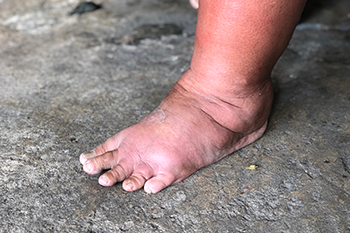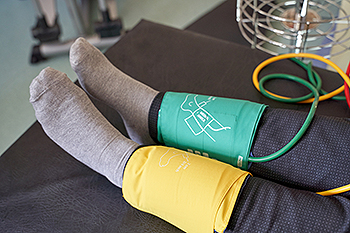Items filtered by date: November 2024
Are You Suffering From Nerve Damage?
Types of Big Toe Pain

Pain in the big toe can arise from various conditions that are often mistaken for bunions. Bunions result from a misalignment causing the base of the big toe to push outward. Arthritis in the big toe joint, known as hallux rigidus, causes pain and stiffness due to degeneration of cartilage. It can result in bone spurs forming on the joint’s top, unlike the side prominence of bunions. Another common cause of big toe pain is gout, where uric acid crystals build up in the joint, leading to intense pain, redness, and swelling. Ganglion cysts can form near the big toe joint. While they can resemble bunions, they also feel softer and are filled with fluid. Bursitis, an inflammation of the bursa near the big toe, can also cause pain and redness due to direct pressure or overuse. A podiatrist can diagnose the cause of your big toe pain and offer effective treatment options appropriate for each condition. If you have big toe pain, it is suggested that you make an appointment with a podiatrist.
Toe pain can disrupt your daily activities. If you have any concerns, contact James Pak, DPM of California. Our doctor can provide the care you need to keep you pain-free and on your feet.
What Causes Toe Pain?
Most severe toe pain is caused due to a sports injury, trauma from dropping something heavy on the toe, or bumping into something rigid. Other problems can develop over time for various reasons.
Toe pain can be caused by one or more ailments. The most common include:
- Trauma
- Sports injury
- Wearing shoes that are too tight
- Arthritis
- Gout
- Corns and calluses
- Hammertoe
- Bunions
- Blisters
- Ingrown toenails
- Sprains
- Fractures (broken bones)
- Dislocations
When to See a Podiatrist
- Severe pain
- Persistent pain that lasts more than a week
- Signs of infection
- Continued swelling
- Pain that prevents walking
Diagnosis
In many cases the cause of toe pain is obvious, but in others, a podiatrist may want to use more advanced methods to determine the problem. These can range from simple visual inspections and sensation tests to X-rays and MRI scans. Prior medical history, family medical history, and any recent physical traumatic events will all be taken into consideration for a proper diagnosis.
Treatment
Treatments for toe pain and injuries vary and may include shoe inserts, padding, taping, medicines, injections, and in some cases, surgery. If you believe that you have broken a toe, please see a podiatrist as soon as possible.
If you have any questions please feel free to contact our office located in Anaheim, CA . We offer the newest diagnostic tools and technology to treat your foot and ankle needs.
Causes and Symptoms of Foot Sprains

A foot sprain occurs when the ligaments in the foot stretch or tear, often the result of sudden twisting motions during strenuous activities or sports. Symptoms of a sprained foot include pain, swelling, bruising, and difficulty bearing weight on the affected foot. Severe sprains may produce a popping sound when the ligament tears. A podiatrist can assess the severity of a foot sprain through an exam and digital imaging. A grade 1 foot sprain involves mild stretching of the ligament, a grade 2 sprain has partial ligament tears causing joint instability, and a grade 3 sprain includes complete ligament tears and significant foot instability. Recovery times vary, with mild sprains healing within weeks, while more severe cases can require several months. Treatment may involve braces, controlled movement, and rehabilitation exercises to aid healing and restore mobility. If you believe you have sprained your foot, it is suggested that you schedule an appointment with a podiatrist for appropriate treatment methods.
Foot Pain
Foot pain can be extremely painful and debilitating. If you have a foot pain, consult with James Pak, DPM from California. Our doctor will assess your condition and provide you with quality foot and ankle treatment.
Causes
Foot pain is a very broad condition that could be caused by one or more ailments. The most common include:
- Bunions
- Hammertoes
- Plantar Fasciitis
- Bone Spurs
- Corns
- Tarsal Tunnel Syndrome
- Ingrown Toenails
- Arthritis (such as Gout, Rheumatoid, and Osteoarthritis)
- Flat Feet
- Injury (from stress fractures, broken toe, foot, ankle, Achilles tendon ruptures, and sprains)
- And more
Diagnosis
To figure out the cause of foot pain, podiatrists utilize several different methods. This can range from simple visual inspections and sensation tests to X-rays and MRI scans. Prior medical history, family medical history, and any recent physical traumatic events will all be taken into consideration for a proper diagnosis.
Treatment
Treatment depends upon the cause of the foot pain. Whether it is resting, staying off the foot, or having surgery; podiatrists have a number of treatment options available for foot pain.
If you have any questions, please feel free to contact our office located in Anaheim, CA . We offer the newest diagnostic and treatment technologies for all your foot care needs.
The Connection Between Swollen Feet and Diabetes

Swollen feet can be a significant concern for individuals with diabetes, often signaling underlying health issues. Diabetes can lead to poor circulation and nerve damage, resulting in fluid retention in the extremities. When blood sugar levels are consistently high, it can cause blood vessels to narrow, impairing circulation and leading to swelling. Additionally, diabetics are at an increased risk for conditions like peripheral edema and kidney disease, both of which can cause foot swelling. It is essential for those with diabetes to monitor their feet regularly, as swelling may indicate complications that require medical attention. If diabetes has caused your feet to become swollen, it is suggested that you are under the care of a podiatrist who can help you to manage this condition.
Swollen feet can be a sign of an underlying condition. If you have any concerns, contact James Pak, DPM of California. Our doctor can provide the care you need to keep you pain-free and on your feet.
Swollen feet are a common ailment among pregnant women and people who stand or sit for extended periods. Aging may increase the possibility of swollen feet and patients who are obese often notice when their feet are swelling too. There may be medical reasons why swollen feet occur:
- Phlebitis - A condition that causes the veins to become inflamed and can also cause leg pain.
- Liver disease - This may lead to low blood levels of albumin which is a protein. This can cause fluid in the blood to pass into the tissues and several areas of the body can become swollen.
- Heart failure - When the heart doesn’t pump properly the blood that is normally pumped back to the heart can pool in the veins of the legs causing swollen feet.
- Kidney disease - One of the main functions of the kidneys is releasing excess fluid in the body. This type of condition can make it difficult for the kidneys to function properly, and as a result the feet may become swollen.
- Deep-vein thrombosis (DVT)- This is a serious condition where blood clots form in the veins of the legs. They can block the return of blood from the legs to the heart which may cause the feet to swell. It is important to be treated by a podiatrist if this condition is present.
Swollen feet can also be caused by bone and tendon conditions, including fractures, arthritis, and tendinitis. Additionally, there may be skin and toenail conditions and an infection may cause the feet to swell. Patients who take medicine to treat high blood pressure may be prone to getting swollen feet.
Many patients elevate their feet to help relieve the swelling and this is generally a temporary remedy. When a podiatrist is consulted the reason behind the swelling can be uncovered and subsequently treated.
If you have any questions please feel free to contact our office located in Anaheim, CA . We offer the newest diagnostic tools and technology to treat your foot and ankle needs.
Peripheral Artery Disease and the Feet

Peripheral arterial disease, or PAD, occurs when blood vessels in the legs and feet become narrowed or blocked, reducing blood flow. The most common cause of PAD is atherosclerosis, where fatty deposits build up in the arteries, restricting circulation. This lack of blood flow affects the feet by causing pain, cramping, or fatigue, especially during walking or physical activity, a condition known as claudication. In severe cases, PAD can lead to non-healing sores or ulcers on the feet and toes, and in extreme cases, gangrene. Symptoms of PAD in the feet include coldness, a bluish tint, or slow-healing wounds. Since diabetes and smoking increase the risk of PAD, managing these conditions is essential. If you have peripheral artery disease it is suggested that you visit a podiatrist who can help monitor foot health, and provide care to prevent further damage.
Peripheral artery disease can pose a serious risk to your health. It can increase the risk of stroke and heart attack. If you have symptoms of peripheral artery disease, consult with James Pak, DPM from California. Our doctor will assess your condition and provide you with quality foot and ankle treatment.
Peripheral artery disease (PAD) is when arteries are constricted due to plaque (fatty deposits) build-up. This results in less blood flow to the legs and other extremities. The main cause of PAD is atherosclerosis, in which plaque builds up in the arteries.
Symptoms
Symptoms of PAD include:
- Claudication (leg pain from walking)
- Numbness in legs
- Decrease in growth of leg hair and toenails
- Paleness of the skin
- Erectile dysfunction
- Sores and wounds on legs and feet that won’t heal
- Coldness in one leg
It is important to note that a majority of individuals never show any symptoms of PAD.
Diagnosis
While PAD occurs in the legs and arteries, Podiatrists can diagnose PAD. Podiatrists utilize a test called an ankle-brachial index (ABI). An ABI test compares blood pressure in your arm to you ankle to see if any abnormality occurs. Ultrasound and imaging devices may also be used.
Treatment
Fortunately, lifestyle changes such as maintaining a healthy diet, exercising, managing cholesterol and blood sugar levels, and quitting smoking, can all treat PAD. Medications that prevent clots from occurring can be prescribed. Finally, in some cases, surgery may be recommended.
If you have any questions, please feel free to contact our office located in Anaheim, CA . We offer the newest diagnostic and treatment technologies for all your foot care needs.

